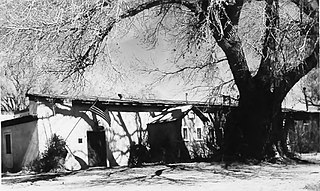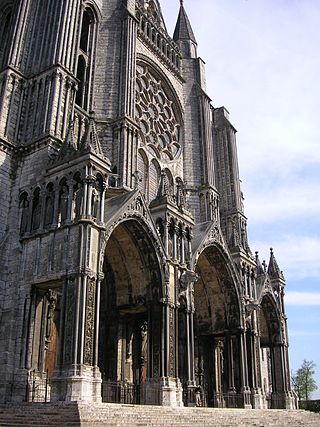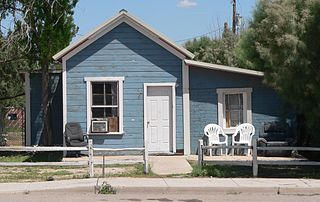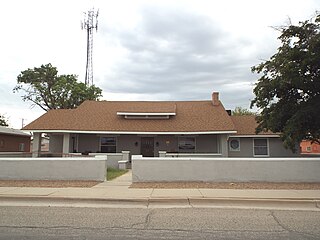
Rancho Petaluma Adobe is a historic ranch house in Sonoma County, California. It was built from adobe bricks in 1836 by order of Mariano Guadalupe Vallejo. It was the largest privately owned adobe structure built in California and is the largest example of the Monterey Colonial style of architecture in the United States. A section of the former ranch has been preserved by the Petaluma Adobe State Historic Park and it is both a California Historic Landmark and a National Historic Landmark. The Rancho Petaluma Adobe State Historic Park is located on Adobe Road on the east side of the present-day town of Petaluma, California.

Kentucky Camp is a ghost town and former mining camp along the Arizona Trail in Pima County, Arizona, United States, near the community of Sonoita. The Kentucky Camp Historic District is listed on the National Register of Historic Places and has been since 1995. As it is located within Coronado National Forest, the United States Forest Service is responsible for the upkeep of the remaining buildings within the Kentucky Camp Historic District.

The Sierra Bonita Ranch, founded in 1872 by Henry C. Hooker, is one of the oldest cattle ranches in the United States and the ranch buildings have been designated a National Historic Landmark. It was the first permanent American cattle ranch in Arizona. Hooker bought neighboring ranches until his operation became the largest ranch in Arizona, totaling 800 square miles (2,100 km2), or about 30 by 27 miles. It is located in Sulphur Springs Valley about 27 miles (43 km) north of present-day Willcox, Arizona. The modern ranch is much smaller but is still operational and owned by Jesse Hooker Davis, the sixth generation to live and work on the ranch.

The Hubert H. Bancroft Ranch House is a historic house museum at 9050 Memory Lane in Spring Valley, California. Built in 1856, it is the oldest Anglo-American building in the town. From 1885 until his death in 1918, it was home to Hubert Howe Bancroft, a pioneering historian of the western United States, Mexico, and Central America. Now managed by the local historical society as a museum, it was designated a National Historic Landmark in 1962 for its association with Bancroft, and was registered as a California Historical Landmark in 1958.

The Faraway Ranch Historic District is part of the Chiricahua National Monument in southeastern Arizona, and preserves an area associated with the final conflicts with the local Apache, one of the last frontier settlements, and in particular, its association with the people who promoted the establishment of the Chiricahua National Monument. Faraway Ranch is located in Bonita Canyon, which lies at an approximate altitude of 5160 feet and opens in a southwesterly direction into the Sulphur Springs Valley.

The Niels Petersen House is a local historic landmark in Tempe, Arizona, that is listed on the U.S. National Register of Historic Places. It is an example of Queen Anne Style brick architecture in the Salt River Valley.

Manistee Ranch was founded in 1897 by Herbert W. Hamilton, a native of Wisconsin. The ranch, located in the town of Glendale, Arizona, was rich in citrus fruits and dates. The ranch has all of its historical structures restored. It is administered by the Parks and Recreation Department of Glendale.

The Arizona Rancho, also known as the Higgins House, Brunswick Hotel and Arizona Hotel, is a former hotel in Holbrook, Arizona, United States. It was originally built between 1881 and 1883 as a residence, the expanded as a boarding house, a hotel, and finally as a motel. The original structure is thought to be the oldest extant structure in Holbrook.

A porch is a room or gallery located in front of an entrance of a building. A porch is placed in front of the facade of a building it commands, and forms a low front. Alternatively, it may be a vestibule, or a projecting building that houses the entrance door of a building.

The Sheldon Boright House, also known as the Grey Gables, is a historic house at 122 River Street in Richford, Vermont. Built in 1890 for a prominent local businessman, it is a fine example of a pattern-book design by Palliser, Palliser & Company, and may be the only instance of a house found on the cover of one of that company's pattern books. Now a bed and breakfast inn, it was listed on the National Register of Historic Places in 1989.

Eagar Townsite Historic District is a section of the town of Eagar, Arizona which has been designated a National Historic Place. Sitting on roughly 54 acres, the site contains 37 structures, 21 of which have historical significance. The period of significance is from 1886, the year the townsite was founded, through 1942, which represents the significant period of development of the town. The site was added to the Register on July 23, 1993.

The North Ann Arbor Street Historic District is a residential historic district, consisting of the houses at 301, 303, and 305-327 North Ann Arbor Street in Saline, Michigan. It was listed on the National Register of Historic Places in 1985.

The Bear Spring House, Guardhouse, and Spring is a late 19th century ranch situated in the Chiricahua Mountains in Cochise County, Arizona

The Benson Railroad Historic District is an area of Benson, Arizona, located near the site of a former passenger and freight depot. The area contains 16 structures, 11 buildings and 5 outbuildings, although the outbuildings are not considered contributing structures to the historic district.

The Johnson-Tillotson House is a Western Colonial Revival home located in Willcox, Arizona, originally built circa 1900 by the Johnson family, a local ranching family, as their in-town residence. It is an adobe structure, in a 2-story Queen Anne architecture. It has a wood shingled high hipped roof, with boxed cornice eaves. The main entry is an off-centered plain lintel wood door, with a wooden screen. And the porch is a recessed platform with no railing, and its own gabled roof.

The Joe Mee House is an historic residence located in Willcox, Arizona. It was added to the National Register of Historic Places in 1987.

The Harry Saxon House is an historic structure located in Willcox, Arizona. It was added to the National Register of Historic Places on March 27, 1987.




















